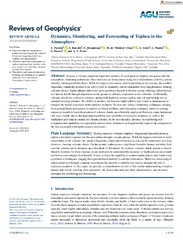Dynamics, Monitoring, and Forecasting of Tephra in the Atmosphere
Autores

Resumen
Explosive volcanic eruptions inject hot mixtures of solid particles (tephra) and gasses into theatmosphere. Entraining ambient air, these mixtures can form plumes rising tens of kilometers until they spreadlaterally, forming umbrella clouds. While the largest clasts tend to settle in proximity to the volcano, the smallestfragments, commonly referred to as ash (≤2 mm in diameter), can be transported over long distances, formingvolcanic clouds. Tephra plumes and clouds pose significant hazards to human society, affecting infrastructure,and human health through deposition on the ground or airborne suspension at low altitudes. Additionally,volcanic clouds are a threat to aviation, during both high‐risk actions such as take‐off and landing and atstandard cruising altitudes. The ability to monitor and forecast tephra plumes and clouds is fundamental tomitigate the hazard associated with explosive eruptions. To that end, various monitoring techniques, rangingfrom ground‐based instruments to sensors on‐board satellites, and forecasting strategies, based on runningnumerical models to track the position of volcanic clouds, are efficiently employed. However, some limitationsstill exist, mainly due to the high unpredictability and variability of explosive eruptions, as well as themultiphase and complex nature of volcanic plumes. In the next decades, advances in monitoring andcomputational capabilities are expected to address these limitations and significantly improve the mitigation ofthe risk associated with tephra plumes and clouds.
Colecciones
Fecha
2024-10Metadatos
Mostrar el registro completo del ítemUtilice este identificador (URI) para citar o enlazar este item
http://hdl.handle.net/20.500.12160/2958El ítem tiene asociados los siguientes ficheros de licencia: